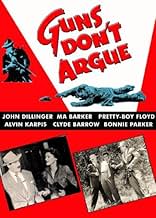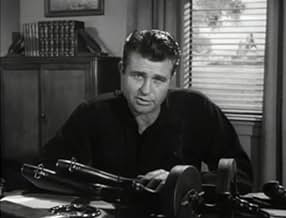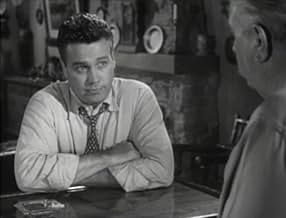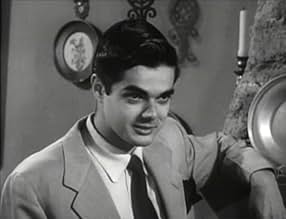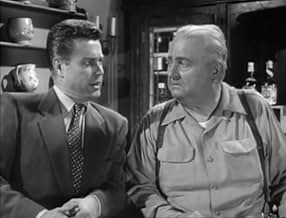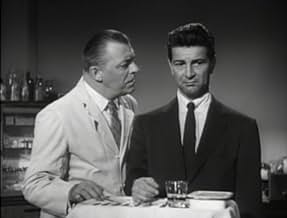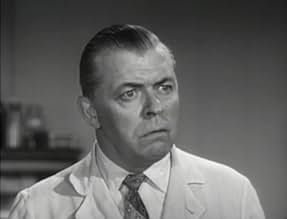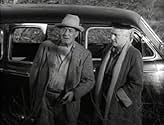Un compuesto de tres episodios reeditados de la serie de televisión de 1952, Gangbusters, estrenados en los cines en 1957 como largometraje. Gang Busters (1954) fue un esfuerzo similar.Un compuesto de tres episodios reeditados de la serie de televisión de 1952, Gangbusters, estrenados en los cines en 1957 como largometraje. Gang Busters (1954) fue un esfuerzo similar.Un compuesto de tres episodios reeditados de la serie de televisión de 1952, Gangbusters, estrenados en los cines en 1957 como largometraje. Gang Busters (1954) fue un esfuerzo similar.
- Dirección
- Guionistas
- Elenco
Baynes Barron
- Clyde Barrow
- (as Baynes Baron)
Lash La Rue
- 'Doc' Barker
- (as Lash Larue)
- Dirección
- Guionistas
- Todo el elenco y el equipo
- Producción, taquilla y más en IMDbPro
Opiniones destacadas
`Guns Don't Argue' is essentially a docu-drama about the war against crime in the 20's and 30's, with particular emphasis on the role of the FBI in that process. It is very much pro-Hoover, pro-law-enforcement, and anti-criminal, and is also quite heavy-handed (often laughably so) in its narration and its portrayals of the criminal element. While offering an interesting counter-point to such romanticisations of the outlaw as Arthur Penn's `Bonnie and Clyde', this movie simply goes TOO far in the opposite direction, to the detriment of what real history it presents.
The worst revisionist moments are in the portrayals of the executions of John Dillinger and of Bonnie and Clyde (interestingly, consistently called `Clyde and Bonnie' in this picture). In reality, each was gunned down maliciously by lawmen who gave no warnings, having set up fool-proof ambushes and using patsies to bait their prey. The vigillantism of law enforcement officials in these days is a legacy America still must live down. In `Guns Don't Argue,' however, Bonnie, Clyde and Dillinger are somehow able to get off the first shots, and the implication is presented that they were given ample opportunity to surrender. Also notably lacking is any sense of the popularity of bank robbers among the American masses, especially after the stock market crash. Dillinger, particularly, was regarded with considerable reverence in the 30's, not the abject fear that this film suggests.
In another interesting twist on history (although a more informed criminal historian will have to bring out the true story), Lyle Talbot takes on a role out of Ed Wood's `Jail Bait' (1954) and is forced to perform plastic surgery on gangster Al Karpis at gunpoint. Those who have seen Ed's original will agree - his `surprise ending' was more effective than this rip-off's.
The best sequence of this movie, however, is that of the vicious `Ma' Barker' and her brood. The little old lady with a Tommy-gun is somehow the most powerful image of the film. The film is quick to point out that the only reason Barker's family attended church was because it helped them avoid jail sentences, of course. Ma' does spend a good deal of screen time in the kitchen, however, reminding us that 50's values cross race, class and even legal lines.
The worst revisionist moments are in the portrayals of the executions of John Dillinger and of Bonnie and Clyde (interestingly, consistently called `Clyde and Bonnie' in this picture). In reality, each was gunned down maliciously by lawmen who gave no warnings, having set up fool-proof ambushes and using patsies to bait their prey. The vigillantism of law enforcement officials in these days is a legacy America still must live down. In `Guns Don't Argue,' however, Bonnie, Clyde and Dillinger are somehow able to get off the first shots, and the implication is presented that they were given ample opportunity to surrender. Also notably lacking is any sense of the popularity of bank robbers among the American masses, especially after the stock market crash. Dillinger, particularly, was regarded with considerable reverence in the 30's, not the abject fear that this film suggests.
In another interesting twist on history (although a more informed criminal historian will have to bring out the true story), Lyle Talbot takes on a role out of Ed Wood's `Jail Bait' (1954) and is forced to perform plastic surgery on gangster Al Karpis at gunpoint. Those who have seen Ed's original will agree - his `surprise ending' was more effective than this rip-off's.
The best sequence of this movie, however, is that of the vicious `Ma' Barker' and her brood. The little old lady with a Tommy-gun is somehow the most powerful image of the film. The film is quick to point out that the only reason Barker's family attended church was because it helped them avoid jail sentences, of course. Ma' does spend a good deal of screen time in the kitchen, however, reminding us that 50's values cross race, class and even legal lines.
This feature-length movie has been edited from episodes of the 1952 TV series, Gangbusters. The style is government informative shorts presented by police agents and promoting their exploits. It dramatizes various gang crews and their ultimate downfalls. Some of the famous names include Pretty-Boy Floyd, Bonnie and Clyde, John Dillinger, and Ma Barker.
In a way, this is an interesting look into early television. As a movie, it is little vignettes that don't gel together. Sure, I remember the shootout with the Barkers. Maybe the final Bonnie and Clyde shootout helps informed the later movie. Far more often, this is a weak production of disjointed scenes and I don't know the vast majority of these actors. The constant changing of the characters do not help.
In a way, this is an interesting look into early television. As a movie, it is little vignettes that don't gel together. Sure, I remember the shootout with the Barkers. Maybe the final Bonnie and Clyde shootout helps informed the later movie. Far more often, this is a weak production of disjointed scenes and I don't know the vast majority of these actors. The constant changing of the characters do not help.
It was, just as it says at the top of the page, several episodes of the syndicated TV series, GANGBUSTERS, stitched together to make a feature-length film for the drive-in and grind-show theatres, and the producers were only interested in getting some more return on their investment...and didn't much care if some theatre patron came away miffed because he had already seen this mess for free on television, scattered across several 30-minute episodes. Each of those told a single story of some gangster or gangs, through some law-enforcement agent, and sometimes had different narrators telling the story.
Based on Philip H. Lord's radio program, and the comic strip of the same name. This is not one of the FBI-endorsed films or, to be exact, television series.
Based on Philip H. Lord's radio program, and the comic strip of the same name. This is not one of the FBI-endorsed films or, to be exact, television series.
TCM showed this movie in October 2016 along with other movies about the FBI. Three of the movies covered gangsters efforts to free one of their own in Kansas City. Those three were "G-Men" (1935), "The FBI Story" (1959, and...this one. The only reason I started watching "Guns Don't Argue" is because Lash LaRue was in the cast, and I wanted to see him play something other than Lash LaRue. By the time his scenes were finished I was near the end of the movie, so I stuck it out. The only reason to watch this movie is to see how similar stories were told by filmmakers with different budgets to work with or, in this case, with no budget at all. In two of the segments the bad guys have face lifts. The first, with the Al Karpis character, results in no change of appearance. The second, at the end involving John Dillinger (played by a guy I always liked -- Myron Healey) resulted in no change either, except for a mustache that kind of looked like a black caterpillar that I kept expecting to walk of his face. A couple of the reviewers stated this looked like an attempt by right-wing individuals trying to put forward their viewpoint. I don't see that; this movie is too incoherent. The only thing that comes out looking bad in this movie are the people who decided to put it together and, if they made any money, the laugh is on us, not them.
So how did this teenage drive-in freak miss a title like this back in '57. Just lucky, I guess. However you look at the 90-minutes, the result is a mess. It's a composite made up of episodes from a 1952 TV series "Gangbusters", while the editing shows more fascination with tommy-guns than anything else. It doesn't matter who the real life desperado is- Dillinger, Karpis, Pretty Boy Floyd- it's the tommy guns that do the talking. Then too, I love the way the Hollywood splatter seldom hits its mark. That way, we get extended bursts. Since there's no plot, just a collection of shoot-outs, don't expect a story. One notable exception is Jean Harvey as the formidable Ma Barker. Her fiery demeanor is scarier than any of the male desperadoes. Looks like her talents could fit into an A-production in an otherwise brief career.
True to its "Dragnet" time period, the aim (if you can call it that) is to laud law enforcement ( here, the FBI) as they gun down a succession of Public Enemy #1's. Also true to the period, the gang molls sport twin peaks and tight skirts- so guys, there are two paramount compensations. Nonetheless, it's a movie unlike any I've seen, or ever want to see.
True to its "Dragnet" time period, the aim (if you can call it that) is to laud law enforcement ( here, the FBI) as they gun down a succession of Public Enemy #1's. Also true to the period, the gang molls sport twin peaks and tight skirts- so guys, there are two paramount compensations. Nonetheless, it's a movie unlike any I've seen, or ever want to see.
¿Sabías que…?
- TriviaAs usual for bottom of the barrel 1950's re-enactments, clothing. furniture, and even automobiles are strictly late 1940s/early 1950s vintage, not 1920s and 1930s especially in the Kansas City Massacre, although the names of notorious gangsters killed in the 1930s, such as Clyde Barrow, Bonnie Parker and Pretty Boy Floyd are tossed around like confetti.
- ErroresThough set in the 1930s, the film's sets, costumes and many of the cars seen in it are all from the 1950s.
- ConexionesEdited from Gang Busters (1952)
Selecciones populares
Inicia sesión para calificar y agrega a la lista de videos para obtener recomendaciones personalizadas
Detalles
- Fecha de lanzamiento
- País de origen
- Idioma
- También se conoce como
- Guns Don't Argue!
- Locaciones de filmación
- Pacific Ave & Windward Ave, Venice, Los Ángeles, California, Estados Unidos(as Beverly Dr & 38th St, Sioux Falls)
- Productora
- Ver más créditos de la compañía en IMDbPro
- Tiempo de ejecución
- 1h 32min(92 min)
- Color
- Mezcla de sonido
- Relación de aspecto
- 1.37 : 1
Contribuir a esta página
Sugiere una edición o agrega el contenido que falta

